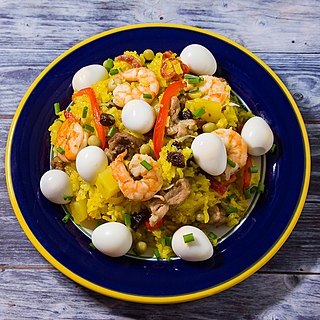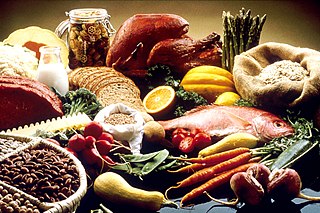
Spanish cuisine consists of the cooking traditions and practices from Spain. It features considerable regional diversity, with important differences between the traditions from each part of the country.

Chowder is a thick soup prepared with milk or cream, a roux, and seafood or vegetables. Oyster crackers or saltines may accompany chowders as a side item, and cracker pieces may be dropped atop the dish. New England clam chowder is typically made with chopped clams and diced potatoes, in a mixed cream and milk base, often with a small amount of butter. Other common chowders include seafood chowder, which includes fish, clams, and many other types of shellfish; lamb or veal chowder made with barley; corn chowder, which uses corn instead of clams; a wide variety of fish chowders; and potato chowder, which is often made with cheese. Fish, corn, and clam chowders are popular in North America, especially New England and Atlantic Canada.

Paella is a rice dish originally from Valencia. While non-Spaniards commonly view it as Spain's national dish, Spaniards almost unanimously consider it to be a dish from the Valencian region. Valencians, in turn, regard paella as one of their identifying symbols. It is one of the best-known dishes in Spanish cuisine.

Fabada asturiana, often simply known as fabada, is a rich Asturian bean stew, originally from and most commonly found in the autonomous community of Principality of Asturias, but widely available throughout the whole of Spain and in Spanish restaurants worldwide. Canned fabada is sold in most supermarkets across the country.

Salvadoran cuisine is a style of cooking derived from the nation of El Salvador. The indigenous foods consist of a mix of Native American cuisine from groups such as the Lenca, Pipil, Maya Poqomam, Maya Chʼortiʼ, Alaguilac, Mixe, and Cacaopera peoples. Many of the dishes are made with maize (corn). There is also heavy use of pork and seafood. Eurasian ingredients were incorporated after the Spanish conquest.

Asturian cuisine refers to the typical dishes and ingredients found in the cuisine of the Asturias region of Spain.

Asturians are a Romance ethnic group native to the autonomous community of Asturias, in the North-West of the Iberian Peninsula.

Arroz a la valenciana or Valencian rice is a name for a multitude of rice dishes from diverse cuisines of the world, which originate from the rice-cooking tradition of the Valencian Community, in eastern Spain.

Chilean cuisine stems mainly from the combination of traditional Spanish cuisine, Chilean Mapuche culture and local ingredients, with later important influences from other European cuisines, particularly from Germany, the United Kingdom and France. The food tradition and recipes in Chile are notable for the variety of flavours and ingredients, with the country's diverse geography and climate hosting a wide range of agricultural produce, fruits and vegetables. The long coastline and the peoples' relationship with the Pacific Ocean add an immense array of seafood to Chilean cuisine, with the country's waters home to unique species of fish, molluscs, crustaceans and algae, thanks to the oxygen-rich water carried in by the Humboldt Current. Chile is also one of the world's largest producers of wine and many Chilean recipes are enhanced and accompanied by local wines. The confection dulce de leche was invented in Chile and is one of the country's most notable contributions to world cuisine.

Neapolitan cuisine has ancient historical roots that date back to the Greco-Roman period, which was enriched over the centuries by the influence of the different cultures that controlled Naples and its kingdoms, such as that of Aragon and France.
Fabes la granxa are a type of white runner bean cultivated in the autonomous community of Asturias. It is primarily used as an ingredient of Fabada Asturiana.

Spaghetti alle vongole, Italian for "spaghetti with clams", is a dish that is very popular throughout Italy, especially in Campania.

Sinabawang gulay, usually anglicized as Filipino vegetable soup, is a Filipino vegetable soup made with leafy vegetables and various other vegetables in a broth seasoned with seafood stock or patis. The ingredients of the dish can vary widely. It is eaten on its own or over white rice.

This is a list of prepared-foods list articles on Wikipedia.

Gising-gising, also known as ginataang sigarilyas, is a spicy Filipino vegetable soup or stew originating from the provinces of Nueva Ecija and Pampanga in the Philippines. It is traditionally made with chopped winged beans, and coconut milk spiced with labuyo chili, garlic, onions, and bagoong alamang. The name literally means "wake up, wake up". It can be eaten alone, on top of rice, or as a side dish to grilled meat dishes. It is a type of ginataan.
María Luisa García Sánchez was a Spanish Asturian chef, cookbook author and leading expert on Asturian cuisine and the culinary traditions of Asturias. Her debut Asturian cookbook, El arte de cocinar, first published in 1970, sold half a million copies and became ubiquitous in home kitchens throughout Asturias. It remains the best selling Asturian cookbook in history. She published a second part of her landmark cookbook, El arte de cocinar in 1982. Her other best known works include Platos típicos de Asturias, released in 1971, and her collaboration with other chefs on El libro de oro de la cocina española, an eight volume encyclopedia of Spanish cuisine.













